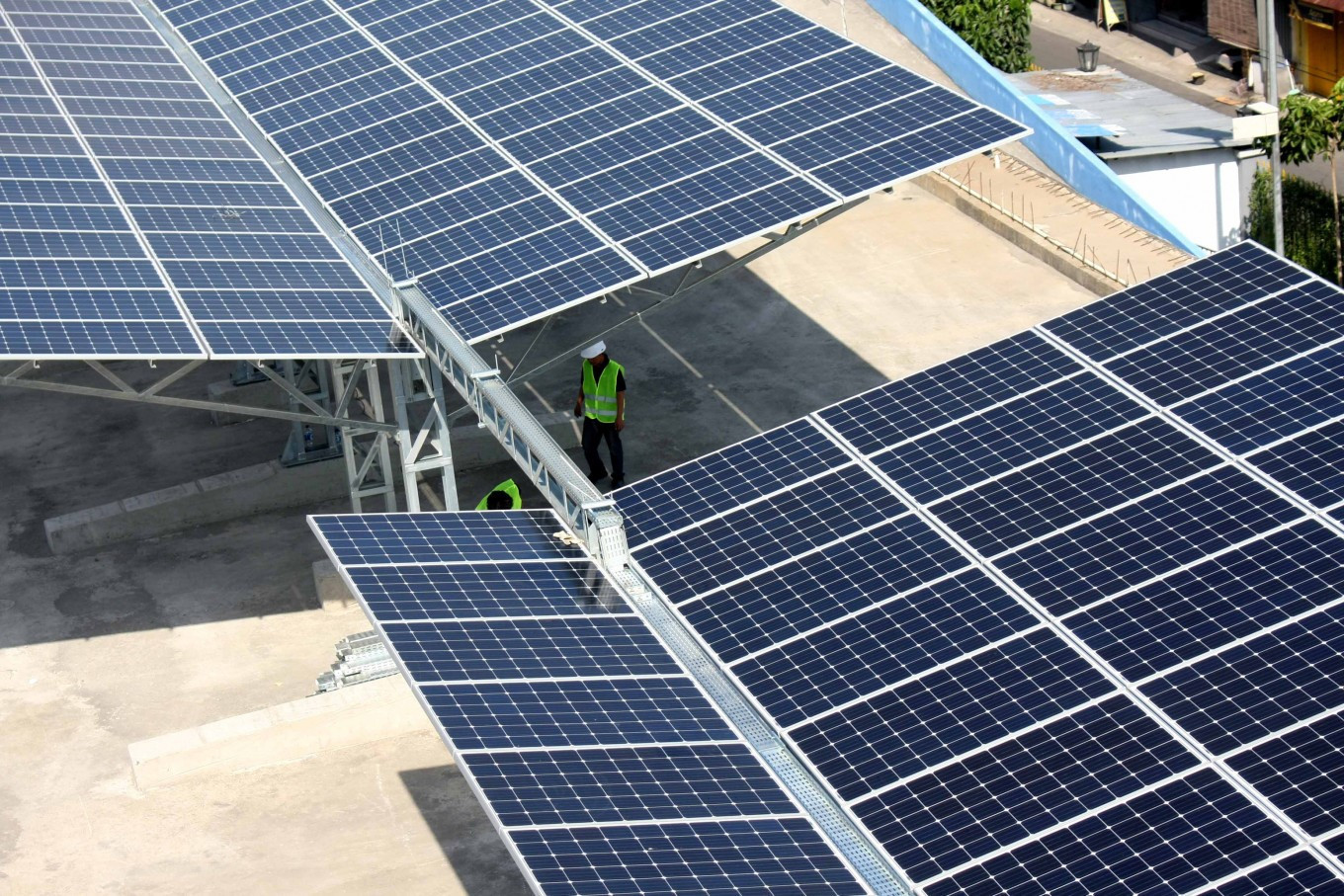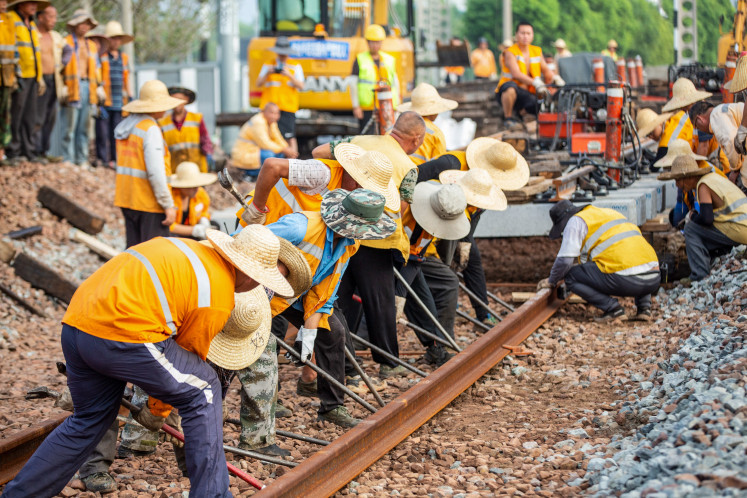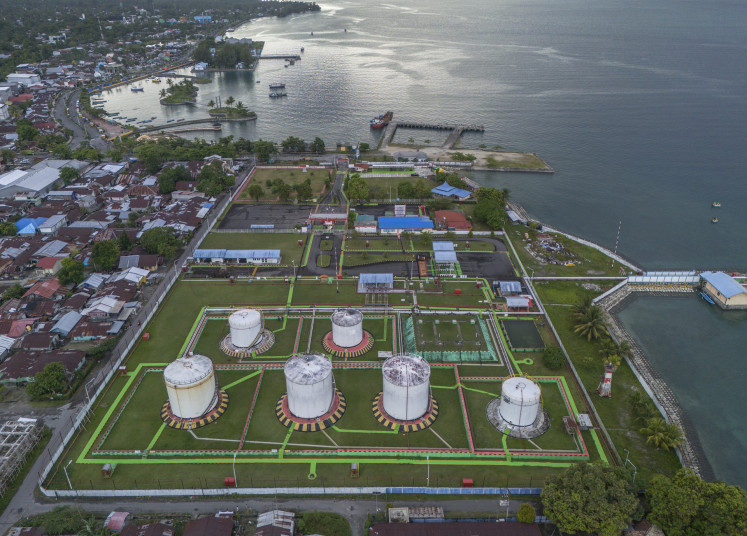Popular Reads
Top Results
Can't find what you're looking for?
View all search resultsPopular Reads
Top Results
Can't find what you're looking for?
View all search resultsPower wheeling, Indonesia’s electricity system: A mismatch
Change text size
Gift Premium Articles
to Anyone
P
ower wheeling, a mechanism that allows private power producers transmit electricity via the state grid directly to their customers, has become the most contentious topic in the deliberation the New and Renewable Energy Bill. There are numerous unresolved questions, especially regarding the challenges, projected consequences, prospective benefits, and a feasible roadmap to implement power wheeling.
Implementing the power wheeling mechanism in Indonesia is difficult because of the integrated structure of the national electricity industry. This tight integration allows state electric company PT PLN to make top to bottom calculations that reduce the cost of electricity from production to consumption. On the other hand, this structure makes the electricity industry more rigid, making it difficult for new players to penetrate the market, especially in the transmission and distribution of electricity.
The power wheeling mechanism is believed to be able to improve the attractiveness of investment in renewable energy. This is because the mechanism would allow private electricity producers or independent power producers (IPP) to rent the existing transmission and distribution infrastructure owned by PLN to transmit electricity directly to customers. This way, the power wheeling mechanism allows high-voltage consumers to have power purchase agreements (PPA) directly with IPPs, thus making it possible for consumers wishing to have electricity from renewables to directly source it from certain IPPs.
The PPA aspect of the power wheeling is important for prospective renewable energy investors, particularly those of RE100 initiative, a global corporate renewable initiative that brings together hundreds of large businesses committed to 60 percent renewable electricity by 2030 and 100 percent by 2050. These corporations have better options to invest in countries such as Vietnam and the Philippines that make it easier for them to get electricity from renewable sources using power wheeling mechanism.
Proponents of the power wheeling in Indonesia argue that the scheme has a viable pathway to implementation through article 4 of Government Regulation (PP) no. 14/2012 on electricity supply business, which states that an opportunity for joint utilization of electricity transmission network for public interest must be open access. The principle of open access would mean that consumers ought to be able to transact directly with IPPs through a rental mechanism on the national transmission network owned by PLN.
Power wheeling got stronger ground with the issuance of the Ministry of Energy and Mineral Resources Minister No. 1/2015 on cooperation for electricity supply and joint utilization of electrical grid, which governs power wheeling in greater details. Under this regulation, power wheeling needs the consent of PT PLN as the owner of the grid, and the rate of the wheeling should be based on negotiations between PT PLN and the IPPs or the consumers.
Despite its legality, power wheeling has not been implemented in Indonesia because of restrictive regulations and the complexity it creates to PT PLN especially to perform economic dispatch, the process of operating and allocating power generation resources to meet electricity demand at the lowest cost while meeting the operational constraints of the electricity transmission network.
On the one hand, these stringent requirements become a barrier to entry for developing markets. On the other hand, they also guarantee the quality of Indonesia’s electricity, allowing it to compete on an even playing field with global electricity powerhouses and maintain the country’s energy sovereignty.
Non-legal challenges
One of the externalities unique to Indonesia is the ongoing electricity oversupply that’s been accelerating since 2020, when electricity demand and usage plummeted due to the COVID-19 pandemic. This condition has caused a massive sink into the nation’s electricity expenses, especially through PLN’s take or pay (TOP) contracts with IPPs, which compels PLN to purchase electricity even when there are no consumers. In 2023 alone, the TOP expenses that were not absorbed by consumers reached Rp 3.4 trillion (US$226 million) out of the cumulative TOP expenses of Rp 3,9 trillion.
In the midst of such a large electricity surplus, the implementation of power wheeling that opens up the market scheme could potentially worsen the ongoing oversupply. As things stand, a large number of Indonesia’s electricity demand comes from high voltage consumers (KTT), many of whom are RE100 members and are aiming to reroute their energy supply chain. The oversupply would worsen considerably if they were to shift their demand away from PLN’s inventory of electricity,
Such a significant drop in demand would then trigger a chain of reaction that would eventually burden PLN’s finance. As oversupply expenses climb, PLN’s financial burdens would no longer be sustainable, and the government would be forced to raise electricity supply costs (BPP) for households.
There is also a capacity barrier against implementing the power wheeling mechanism. PLN’s current transmission infrastructure would need to be expanded to have a leasable segment without damaging PLN’s own transmissions. This would naturally require a large amount of investment. Depending on the cost and time needed to build the new infrastructure, the power wheeling mechanism could risk a spike in the price of Indonesia’s electricity, as the investors would want a return on their investment.
Furthermore, even under the best-case scenario, if PLN were to start offering leasing schemes for their infrastructure, existing contracts with other IPPs, including those that are not planning to lease, would need to be modified to maintain the affordability of electricity prices for most consumers.
Additionally, the implementation of power wheeling has not been a part of any national energy transition initiative. Not only is there a lack of a feasible roadmap to its implementation, but power wheeling is also not included in the projections made by other energy transition roadmaps such as the long-term electricity procurement plan (RUPTL) or any other roadmap to meet national net zero emissions (NZE) commitments.
This would also mean that power wheeling could potentially conflict with other initiatives to promote the development of the renewable energy sector. An example of this would be PLN’s renewable energy certificate (REC), which enables the utilization of renewable energy already on the grid without the need for additional grid capacity.
Moreover, PLN is also in the midst of increasing its renewable energy capacity as well. According to the RUPTL 2021-2030, PLN targets an increase to their renewable energy capacity up to 20.9 gigawatts (GW) or 51 percent of the total additional electricity capacity by 2030. Theoretically, RE100 members would still be able to reach their 2030 commitments once PLN hits these capacity targets.
There is no urgency to implementing the power wheeling scheme in Indonesia as things currently stand. Even if it was not implemented, Indonesian electricity generation will eventually develop to be primarily sourced from renewables. Meanwhile, implementing the mechanism risks exacerbating issues such as the electricity oversupply and introducing new market disruptions through power trading.
A feasible power wheeling mechanism
While there is no urgency on a national level to implement the power wheeling scheme, a demand for it does exist, especially from RE100 members operating in Indonesia. If power wheeling is to be implemented, then a number of improvements are required at the policy and regulatory level as well as some adjustments to the mechanism itself to truly bring the desired benefits without having to increase the burden on PLN and the state.
The first step is to harmonize the existing laws and regulations to be able to seamlessly integrate power wheeling with Indonesia's electrical sector legal framework. Without some adjustments, the power wheeling mechanism that allows for power trading would be similar to the unbundling practice that was deemed to violate article 33 of the constitution through Constitutional Court Decree no. 111/PUU-XIII/2015.
The underlying concern with both unbundling and power trading is that they expose the Indonesian electricity sector to market volatility. The current integrated model, while rigid, is able to stabilize prices on all levels of the energy supply chain, from generation to transmission and distribution. Opening market access would have to still be able to control the price level to a similar extent.
Afterwards, the adjusted power wheeling scheme would also need to guarantee itself to be non-discriminatory. As Indonesia is an archipelago country, this may be much easier said than done. Most high voltage customers are located in industrial regions, which in turn would make their relevant transmission infrastructures more valuable, especially compared to the transmission infrastructure for rural villages or isolated islands.
The adjusted power wheeling mechanism must also guarantee that PLN’s economic dispatch remains undisturbed. To that end, PLN would have to be given disproportionately larger negotiating rights as the lessor of the transmission infrastructure. This may include almost all if not the entirety of the transmission equipment’s maintenance costs being covered by the lessors.
Also, the implementation of power wheeling should also consider the inevitable loss of electricity demand as high voltage consumers’ transition from using PLN’s overall electricity inventory to directly sourcing from specific IPPs. This issue is one of the most difficult as it does not have a short-term solution. In the end, it rests with PLN, and the government, how to deal with these issues to allow power wheeling part of the country’s electricity system.
To read the full report https://tenggara.id/power-wheeling.
This article is written in partnership with Tenggara Strategics










